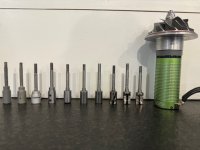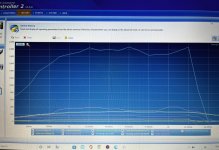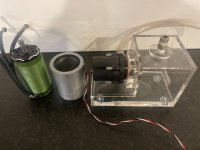Well, it has been a long time since I have posted. I have learned a lot about and advanced my capabilities on the lathe, made a lot of extension shafts. I have learned a lot about machining and measuring concentricity. I have systematically eliminated one problem at a time, but still don’t have a viable extension shaft for my eturbo motor.
I think I have tried over a dozen metal extension shafts, all of which were fails. Below is a picture of a fair representation of the iterations.

Starting on the left was 3D printed ABS. Very concentric, spun up nicely, but only good for a short life and basement experiments and design work. Then I tried getting a laser sintered shaft, which was plenty strong, not concentric enough (they printed it horizontal and it dropped).
3rd in, I tried using the 1/4” shaft that came with the turbo with 1/4” to 8mm adaptor. The challenge I had was the coupler was not concentric or balanced enough.
4th in, a friend made a steel shaft on his lathe for me. The shaft is amazingly concentric with less than a thousandth run out. But it got wonky with the set screw attachment to the motor shaft.
Then I got my own lathe (nice complement to my milling machine) and have been learning over the last few months (good choice for me as I am learning driven and build lots of car parts). The next few shafts had poor tolerances for the 1/4” shaft and 6 mm bearing and or shrink fit. So they never were tried with the motor.
At first it was hard to get the precision for the shrink fit. But once you have the right tools, setup, procedure, and technique, it is quite easy and repeatable.
All I do is drill with a center drill, then increasing drill sizes up to 7.75 mm and finish up with 0.3035” reamer. The shaft is 7.98 mm = 0.3242”. So the hole is roughly 0.0007” smaller than the shaft at room temp or about 18 microns. Once the shaft is complete I heat it up with the torch for 15-20 seconds and it slides right onto the motor shaft. Once it cools down, the only way I can get extension shaft off of the motor is to cut it off (which I have done too many times).
I eventually abandoned turning the shaft in lathe chuck and have been turning between centers to improve concentricity. The last shaft I made (perhaps my 10th or so out of steel) was concentric to ~ 1 thousandth of an inch. However, after heat shrinking it onto the motor the shaft runout went to about 14 thousandths of an inch. Arghh (again). I have not spun this one up beyond 2 psi due to vibration.
My hypothesis is that there is a lot of force or weird cooling at the flat spot on the shaft causing the deformation during heat shrinking. I have taken many a good shaft and destroyed the concentricity with heat shrinking it onto a shaft with a flat spot. If that is the case, my motor is probably not viable for my application. If that is not it, perhaps my motor rotor itself has poor concentricity (again not viable).
Next steps:
- Cut off current extension shaft from motor
- Measure concentricity of motor rotor
- Turn a pin in lathe to motor shaft specs and heat shrink a shaft onto it and check concentricity (this will test above hypothesis)
- Call Castle and see if they will send to me a rotor for my motor without a flat spot.
Let me know if you any other thoughts…
Too bad as I was excited for a usable shaft. It was highly concentric (before heat shrinking) and had even balanced my rotating assembly.



